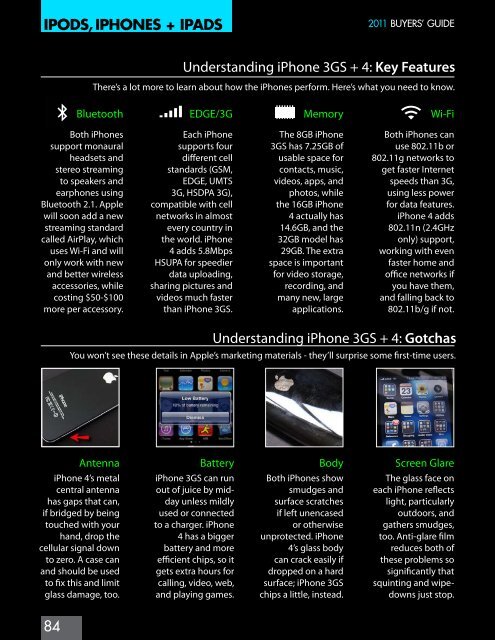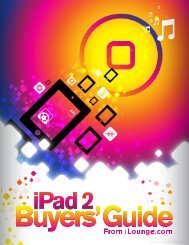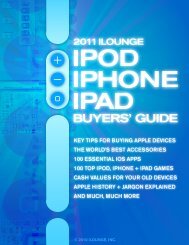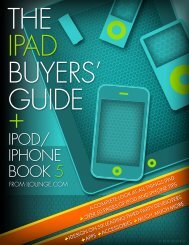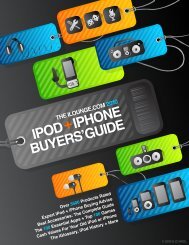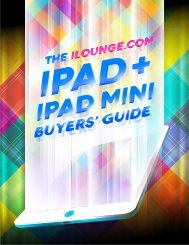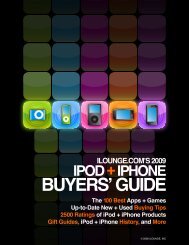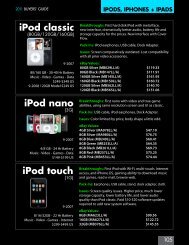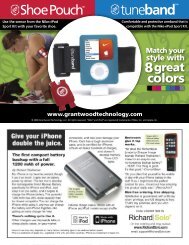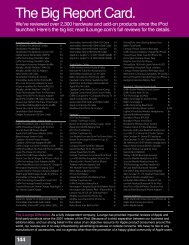2011 iLounge iPod/iPhone/iPad Buyers' Guide
2011 iLounge iPod/iPhone/iPad Buyers' Guide
2011 iLounge iPod/iPhone/iPad Buyers' Guide
You also want an ePaper? Increase the reach of your titles
YUMPU automatically turns print PDFs into web optimized ePapers that Google loves.
ipods, iphones + iPADS<br />
<strong>2011</strong> Buyers’ <strong>Guide</strong><br />
Understanding <strong>iPhone</strong> 3GS + 4: Key Features<br />
There’s a lot more to learn about how the <strong>iPhone</strong>s perform. Here’s what you need to know.<br />
Bluetooth<br />
EDGE/3G<br />
Memory<br />
Wi-Fi<br />
Both <strong>iPhone</strong>s<br />
support monaural<br />
headsets and<br />
stereo streaming<br />
to speakers and<br />
earphones using<br />
Bluetooth 2.1. Apple<br />
will soon add a new<br />
streaming standard<br />
called AirPlay, which<br />
uses Wi-Fi and will<br />
only work with new<br />
and better wireless<br />
accessories, while<br />
costing $50-$100<br />
more per accessory.<br />
Each <strong>iPhone</strong><br />
supports four<br />
different cell<br />
standards (GSM,<br />
EDGE, UMTS<br />
3G, HSDPA 3G),<br />
compatible with cell<br />
networks in almost<br />
every country in<br />
the world. <strong>iPhone</strong><br />
4 adds 5.8Mbps<br />
HSUPA for speedier<br />
data uploading,<br />
sharing pictures and<br />
videos much faster<br />
than <strong>iPhone</strong> 3GS.<br />
The 8GB <strong>iPhone</strong><br />
3GS has 7.25GB of<br />
usable space for<br />
contacts, music,<br />
videos, apps, and<br />
photos, while<br />
the 16GB <strong>iPhone</strong><br />
4 actually has<br />
14.6GB, and the<br />
32GB model has<br />
29GB. The extra<br />
space is important<br />
for video storage,<br />
recording, and<br />
many new, large<br />
applications.<br />
Both <strong>iPhone</strong>s can<br />
use 802.11b or<br />
802.11g networks to<br />
get faster Internet<br />
speeds than 3G,<br />
using less power<br />
for data features.<br />
<strong>iPhone</strong> 4 adds<br />
802.11n (2.4GHz<br />
only) support,<br />
working with even<br />
faster home and<br />
office networks if<br />
you have them,<br />
and falling back to<br />
802.11b/g if not.<br />
Understanding <strong>iPhone</strong> 3GS + 4: Gotchas<br />
You won’t see these details in Apple’s marketing materials - they’ll surprise some first-time users.<br />
Antenna<br />
Battery<br />
Body<br />
Screen Glare<br />
<strong>iPhone</strong> 4’s metal<br />
central antenna<br />
has gaps that can,<br />
if bridged by being<br />
touched with your<br />
hand, drop the<br />
cellular signal down<br />
to zero. A case can<br />
and should be used<br />
to fix this and limit<br />
glass damage, too.<br />
<strong>iPhone</strong> 3GS can run<br />
out of juice by midday<br />
unless mildly<br />
used or connected<br />
to a charger. <strong>iPhone</strong><br />
4 has a bigger<br />
battery and more<br />
efficient chips, so it<br />
gets extra hours for<br />
calling, video, web,<br />
and playing games.<br />
Both <strong>iPhone</strong>s show<br />
smudges and<br />
surface scratches<br />
if left unencased<br />
or otherwise<br />
unprotected. <strong>iPhone</strong><br />
4’s glass body<br />
can crack easily if<br />
dropped on a hard<br />
surface; <strong>iPhone</strong> 3GS<br />
chips a little, instead.<br />
The glass face on<br />
each <strong>iPhone</strong> reflects<br />
light, particularly<br />
outdoors, and<br />
gathers smudges,<br />
too. Anti-glare film<br />
reduces both of<br />
these problems so<br />
significantly that<br />
squinting and wipedowns<br />
just stop.<br />
84


